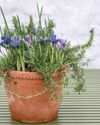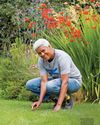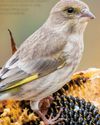
Bishop of Llandaff' has a lot to answer for. Not so long ago, dahlias were as de rigueur as plastic gnomes and not half as ironic. They were untrendy, unfashionable and, more often than not, simply ghastly. Then along came the Bishop, with his rich alizarin robes and brilliant chrome-yellow centre. He quickly became popular among the very people who hated dahlias, setting a thoroughly bad example. Then before you could say 'Arabian Night' or 'Grenadier', dahlias started popping up all over gardens that had hitherto known better - and we had all come to just adore them.
Well, almost... not the nasty vulgar sort, of course, the dahlias that looked like a deliciously brash wedding hat, sitting over a raucous laugh, with a fag in one hand, and a gin and orange in the other. Not the dahlias that were grown with a quiet fanaticism on allotments across the country and then displayed singly, like floral haiku, in canvas marquees at lateseason flower shows across the land. And not dahlias in the wrong place and not dahlias getting uppity in the border. But the right sort of dahlias - like the right sort of people, really - were such fun!
Big and bold
I grew up with dahlias. They are part of the flora of my strange childhood. My mother grew the big, cactus-flowered dahlias, all lipstick pinks, brassy yellows and shouty reds. They had their own bed next to the veg and were relegated - in a kind of apartheid, along with gladioli - to a cutting garden. Here, the soil was bare and every plant was supported by a stout square stake, of a kind we used for nothing else in the garden and that lived bundled at the back of the shed for most of the year.
This story is from the {{IssueName}} edition of {{MagazineName}}.
Start your 7-day Magzter GOLD free trial to access thousands of curated premium stories, and 9,000+ magazines and newspapers.
Already a subscriber ? Sign In
This story is from the {{IssueName}} edition of {{MagazineName}}.
Start your 7-day Magzter GOLD free trial to access thousands of curated premium stories, and 9,000+ magazines and newspapers.
Already a subscriber? Sign In

Tales from Titchmarsh
Tending the land is a rewarding if undervalued career, and it's also the best way to safeguard our future on this planet 'Same old, same old...' is a phrase that sends a shiver down my spine. Friends who have hoed the same furrow (pardon the gardening analogy) year after year in a job that pays the rent but which they do not like have my deepest sympathy.

Container of the month
Mark fresh beginnings with a hit of colour, combining bright evergreens and early risers

Boost your wellness the natural way
Gardening is good for you! Six inspiring experts reveal how getting your hands into soil, growing beneficial plants and connecting with nature can transform all aspects of your health.

Potting on a winter show PART 2
Nick Bailey banishes January blues with a sophisticated container display that's guaranteed to lift the spirits

Winter scents
Fragrant flowers can help lift the spirits on cold winter days. Monty shares his favourite plants to fill the garden with olfactory joy

Growing THE GOOD LIFE
If you've always wanted your own mini farm, let urban smallholder Sara Ward show you how

Arit's 7 deadly sins
Discover Arit Anderson's guilty gardening secrets and how you can turn your own sins into wins

Garden globetrotting
Desert Botanical Garden, Phoenix Garden globetrotting Fancy a new look for your plot or just want to try something different? Our new series about gardens around the world could be just the ticket. This month, Matt Collins reveals what captured his heart in Arizona

10 nature-led ways to feed birds
Want to give wild birds a natural boost this winter? Kate Bradbury explains how to attract a wide diversity of birds to forage within your garden and why this is so beneficial

A new plot for tasty crops
Taking on a new allotment needn't be hard work. By simply following a few easy tips you can have bumper crops in no time, just like Alessandro Vitale